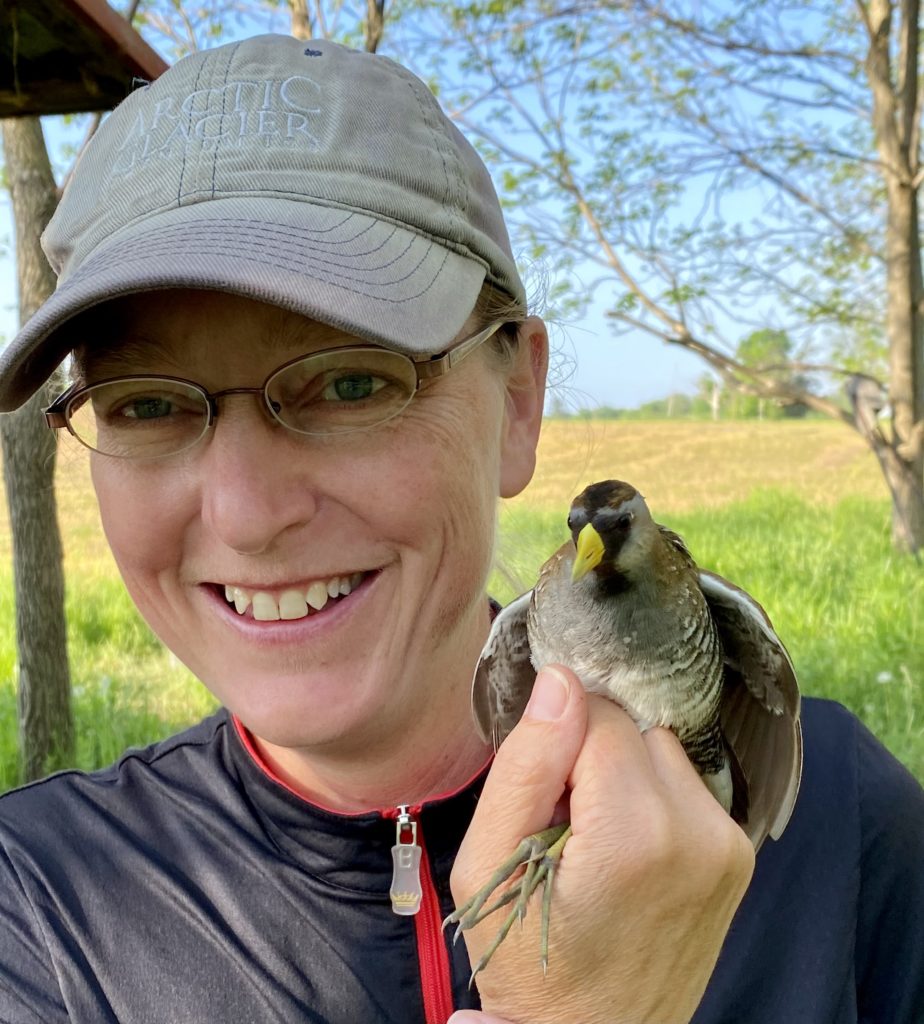
It’s always very exciting to add a new species to the “banded” list of a station. Marnie had the (well-deserved) honour of catching and banding our firs Sora. -KMP
A new beginning in a new environment – a very different environment than I’ve banded in over the past 25 years. We were right on the edge of a wetland studded with old willows, reed beds, open grassy areas, a few areas of scrub, and bordered on the north side by the Grand River and the south side by farm fields. So this was part of an “experimental” year – looking to see the banding possibilities that the area holds. [Many thanks to Bill and Elizabeth Hurkmans for inviting us to use their site and building a state-of-the-art outhouse for us. Also to the Haldimand Stewardship Council for providing us with a banding cabin. It’s a very peaceful place to be. When things open back up we’ll put in a picnic table for people to lounge around and exchange sightings, experiences and…..baked goods.]
One of the first things to come to grips with was the water, especially early in the Spring. The large pond spread across the property running east-west requiring that we do some wading to get to half the nets. This generated a lot more exercise than we had been used to. Obviously good rubber boots were a necessity. For some reason mine always tend to become “semi-permeable” part way through the season – and they did this season as well. [Does anyone have a line on rubber boots that will last more than 2 months?]
We decided that, as we didn’t really know what the site might offer, we would run a limited number of nets but try to position them in such a way that the various habitats would be sampled. We ended up running 9 nets in 8 lanes. This worked very well – more would have required extra person-power to run net rounds – a possibility for the future. We also used a couple of ground traps in the vicinity of a feeder. This proved to be useful and we will put in a better feeder system for the future – one less susceptible to squirrel (and deer) predation.
As we were not running this as a “migration monitoring station” we did not consistently follow a strict protocol of predawn openings and a 6-hour banding period, although on many days we approached this. We kept good track of observations but didn’t do a formal census (although on some days members of the HNC Pipits would come and do this for us). This is something we will aim for when things open back up.
Sometimes the bander-in-charge (Marnie or myself) was there alone but most of the time I was able to schedule volunteers to join in and help with scribing, extracting, observing, etc. The number each day was necessarily strictly limited but it was nice to have the help, continue (in some cases) training, and enjoy some camaraderie – the thing I think we all miss the most in the midst of this pandemic.
Results:
(As this is the first season here I have no basis for comparison – these results will provide the baseline.)
In April we banded 200 birds and, in May, 467 for a total of 667. This total was made up of 64 species. We started banding on April 1st and ended on May 31st; however, for a variety of (mostly) manpower issues, we banded on only 47 days (77%) – 20 in April; 27 in May. Our “big day” was may 15th when we banded 41 birds of 21 species.
Frankly, I was fairly disappointed by April’s results. I had expected a lot more birds. But weather paid a huge part in these results, especially the rash of storms and cold, wet weather to the south of us which held migration up – we didn’t start seeing mid-distance migrants in any numbers until the very end of April and then well into May (when you would expect that they would have all passed) numbers tailed off dramatically. Still…..it was exciting. And for next Spring, if we get the help to run them, I am looking forward to placing a few more nets in spots that, through this experience, will be productive.
I always keep track of our net hours (1 x 12m net open for an hour = 1 net hour) and I calculate the rate of capture: the number of birds per 100 net hours. This gives us a basis for comparison between nets, between days, and between years. I wondered how our results would compare with our experience at Ruthven. I was quite surprised. Despite the low number in April our birds/100 net hours was 29.2 (compared with 14.9 at Ruthven the year before). May was 35.0 (compared to 34.0) and our overall total was 33.04 (vs 26.4).
[For those of you that are familiar with the nets/numbering, the most productive net, both in terms of overall numbers caught and in the rate of capture, was #1. This net is in a gray dogwood thicket and right on the edge of the pond. Based on this….we have to concentrate on expanding the amount of dogwood on the site!! Migrants love them and, in the Fall, their fruit, which has a high lipid content, is a necessity for fattening up for the long flight south.]
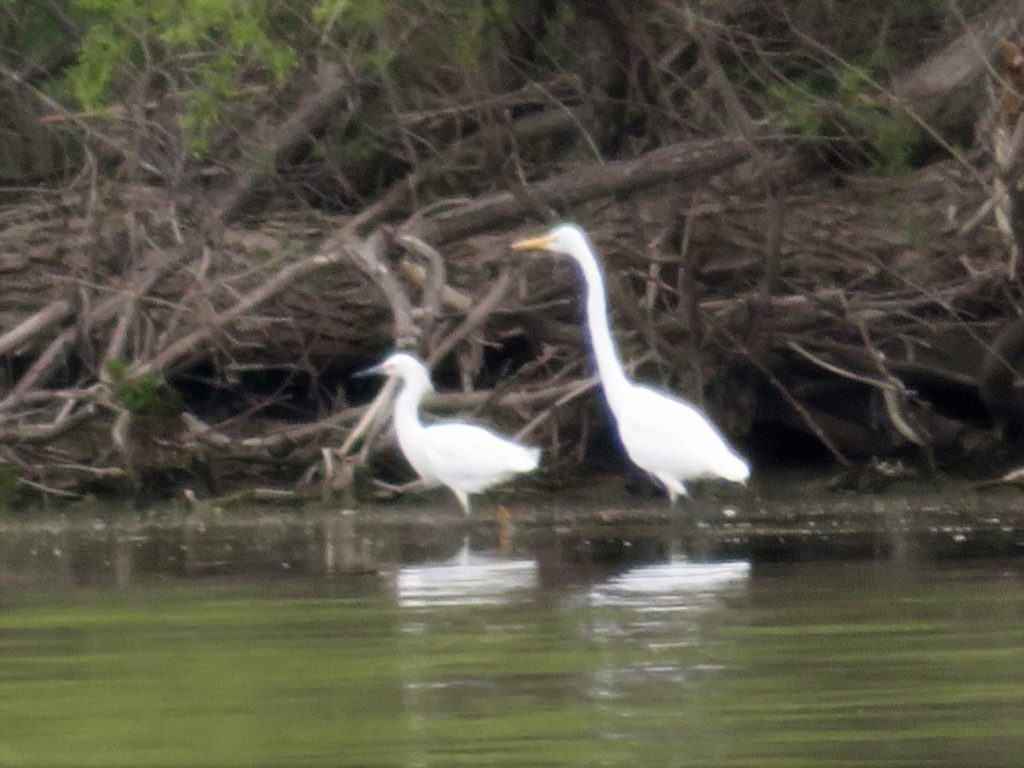
We have been quite pleasantly surprised lately: first there was an influx of 5 Great Egrets and then, yesterday, they were joined by this Snowy Egret (smaller bird on the left with a black bill, head plume, and yellow feet). We tend to think of these as denizens of the southern United States. -KMP
We tried to keep a good count of birds on or flying over the site (including the river) but negotiating boot-topping ponds and mud holes can sometimes cause one’s attention to flying birds to waver. Still, we managed to record 127 species, the most notable being a Snowy Egret which hung around for a couple of days.
Banding Top Ten:
1. Red-winged blackbird – 81
2. American Goldfinch – 54
3. Song Sparrow – 47
4. Swamp Sparrow – 38 (one of the pluses of banding in a wetland)
5. Common Yellowthroat – 32
6. Tree Swallow – 27
7. Yellow Warbler – 24
8. American Robin – 23
9. Brown-headed Cowbird – 22
10. White-throated Sparrow – 20
Photos:
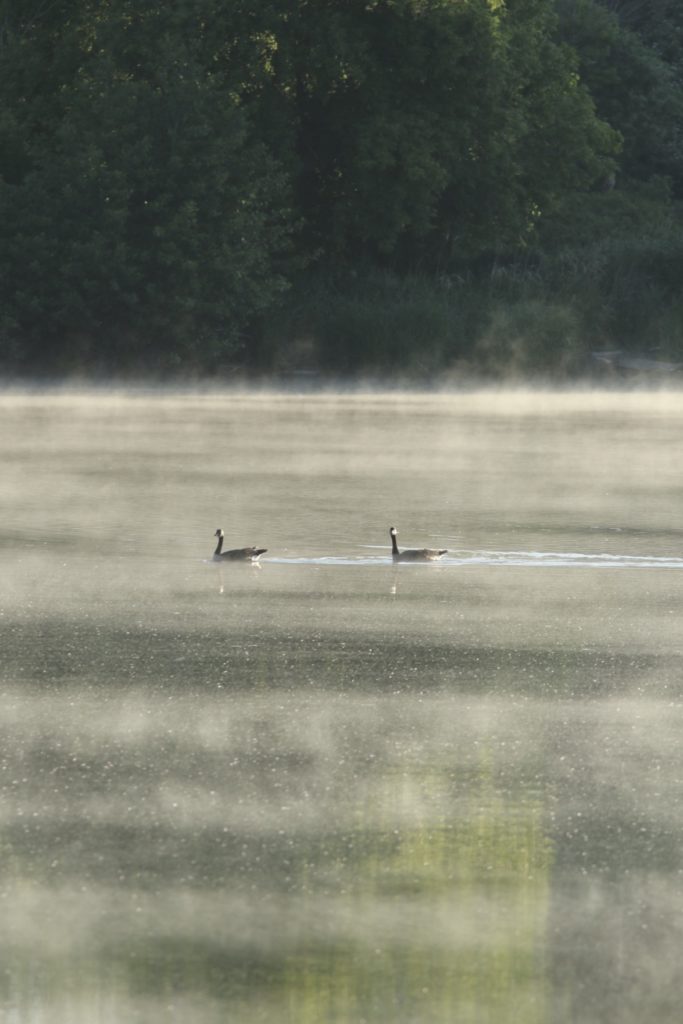
Canada Geese in the early morning mist. The young ones have fledged and are growing quickly. A new generation is on the way.,
-MMG
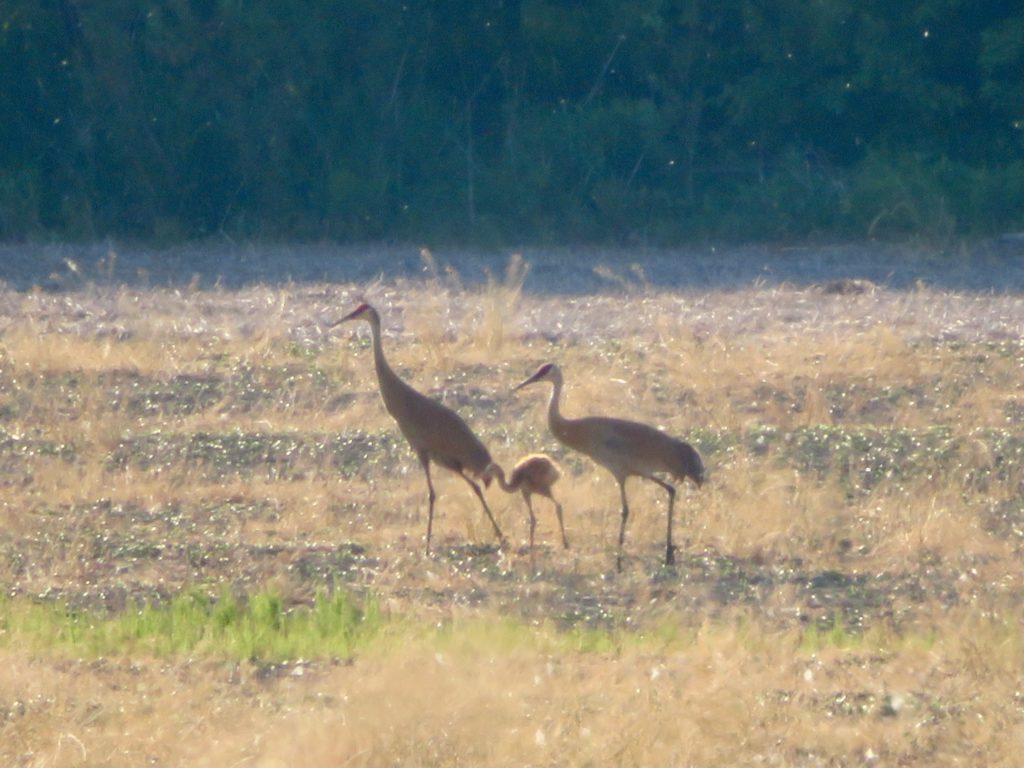
There are at least 2 pairs of Sandhill Cranes with young within a few k9ilometers of the banding area. -KMP
[Food for thought: I was wondering how other banders were finding their season – especially when I thought about how dismal April seemed to be. Here’s a comment from Pelee Island BO (where alumnus Alessandra Wilcox was the assistant bander: It was the quietest banding season which I had experienced in the past fifteen years – we banded less than a half of previous spring seasons. Especially the large volume of migratory warblers was missed during both census and netting period.
Rob Tymstra]
And speaking of alumni: I got a note from Tessa Gayer who now is at Trent University. She has been hired this Spring/Summer to study Horned larks and Lapland Longspurs in Nunavut – Baker Lake to be exact. That’s exciting news!
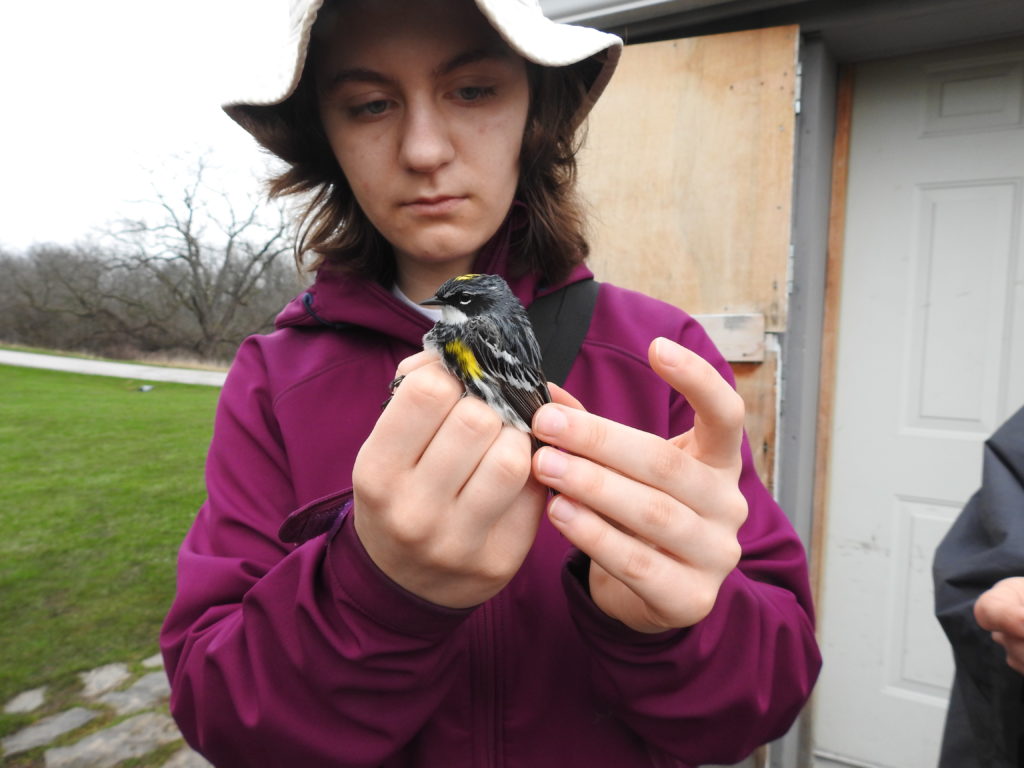
Tessa, seen here releasing a myrtle Warbler, is now in Nunavut studying Lapland Longspurs and Horned Larks. -HG
And while we were trying to sort out “the Farm”, Ben Oldfield was running his fine station just outside of Lowville. Here’s his report:
Hello Everyone,
This is a brief summary of the banding that took place in the Lowville area, more specifically some land on the Bruce trail (Burlington, Halton region). In total we banded 557 birds of 53 species. This number is decent considering banding only took place 2-3 times a week and not for the full 6 hours as it did at Ruthven. David Brewer, Marnie, Catherine, and Rick played a huge role in keeping the station operational this spring! This station saw many highlights including banding a Golden Winged Warbler, Connecticut Warbler and White Eyed Vireo. These are all rare in this part of the province!
The top 5 banded birds for the season and their % of the total are as follows:
1. American Goldfinch – 101 (18.1%)
2. White Throated Sparrow – 75 (13.4%)
3. Ruby Crowned Kinglet – 69 (12.3%)
4. Slate Coloured Junco – 41 (7.3%)
5. Black Capped Chickadee – 22 (3.9%)
As you can see the top 5 accounted for 55% of all birds banded. Overall, the season was successful except for the lack of volunteers and visitors. Hopefully this Fall will allow for more visitors and some hands-on learning experience.
Ben Oldfield

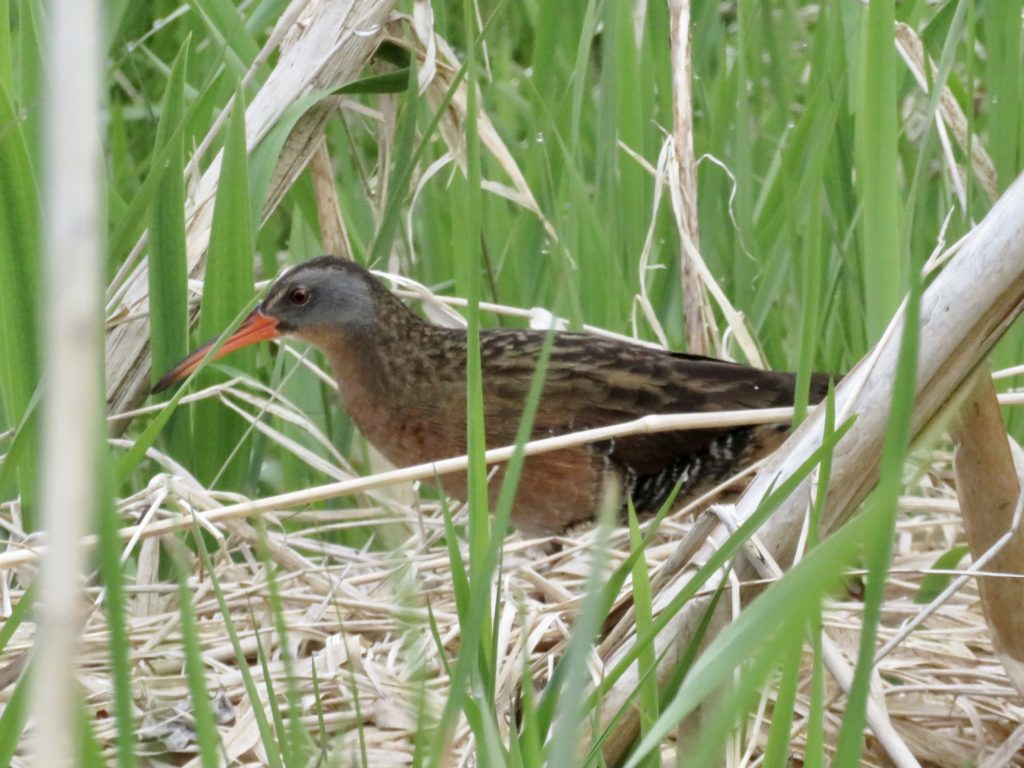









Thanks for the information! Voth sites seem to be bringing in lots of species!
Yes, both seem quite promising. I’m looking forward to seeing what the Fall brings. We’ve already had some discussion about increasing the number of nets at the Farm site by 3 or 4. Catherine you should make a point of getting down there.